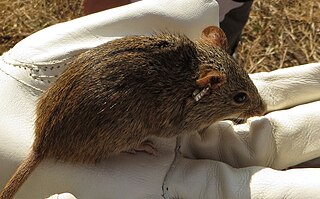
Apodemus is a genus of Muridae. The name is unrelated to that of the Mus genus, instead being derived from the Greek ἀπό-δημος.

The rusty-spotted genet, also called panther genet and large-spotted genet, is a genet that is widely distributed in sub-Saharan Africa. It is considered common and therefore listed as Least Concern on the IUCN Red List.

Lemniscomys, sometimes known as striped grass mice or zebra mice, is a genus of murine rodents from Africa. Most species are from Sub-Saharan Africa; L. barbarus is the only one found north of the Sahara. They are generally found in grassy habitats, but where several species overlap in distribution there is a level of habitat differentiation between them.
Father Basilio's striped mouse or the Bioko hybomys is a species of rodent in the family Muridae. It is found only in Equatorial Guinea. Its natural habitat is subtropical or tropical moist montane forest. It is threatened by habitat loss.
Eisentraut's striped mouse or Eisentraut's hybomys is a species of rodent in the family Muridae. It is found only in Cameroon. Its natural habitat is subtropical or tropical moist montane forests. It is threatened by habitat loss.
The moon striped mouse or Ruwenzori hybomys is a species of rodent in the family Muridae. It is found in Democratic Republic of the Congo, Rwanda, and Uganda. Its natural habitat is subtropical or tropical moist montane forests. It is threatened by habitat loss.
Miller's striped mouse or the Liberian forest hybomys is a species of rodent in the family Muridae. It is found in Ivory Coast, Guinea, Liberia, and Sierra Leone. Its natural habitats are subtropical or tropical dry forest, subtropical or tropical moist lowland forest, and subtropical or tropical moist montane forest.
Temminck's striped mouse or West African hybomys is a species of rodent in the family Muridae. It is found in Ivory Coast, Ghana, Guinea, Liberia, Nigeria, and Sierra Leone. Its natural habitat is subtropical or tropical moist lowland forest. It is threatened by habitat loss.
Peters's striped mouse or Peters's hybomys is a species of rodent in the family Muridae. It is found in Angola, Burundi, Cameroon, Central African Republic, Republic of the Congo, Democratic Republic of the Congo, Equatorial Guinea, Gabon, Nigeria, Rwanda, Uganda, and Zambia. Its natural habitats are subtropical or tropical dry forest, subtropical or tropical moist lowland forest, and subtropical or tropical moist montane forest.
Griselda's lemniscomys or Griselda's striped grass mouse is a species of rodent in the family Muridae.
Hoogstraal's lemniscomys or Hoogstraal's striped grass mouse is a species of rodent in the family Muridae. It is known only from the type specimen collected in 1961 at Paloich, north of Niayok, South Sudan.
Lemniscomys linulus, commonly known as the Senegal grass mouse or Senegal one-striped grass mouse, is a species of rodent in the family Muridae. It is found in Ivory Coast, Guinea, Mali, and Senegal and its natural habitat is dry savanna. At one time considered to be a subspecies of Lemniscomys griselda, it is now accepted as a species in its own right.
Mittendorf's lemniscomys or Mittendorf's striped grass mouse is a species of rodent in the family Muridae. It is endemic to Cameroon where it is found at high elevations on a single mountain. Its natural habitat is tropical high-altitude grassland. It faces no particular threats and the International Union for Conservation of Nature has listed it as being of "least concern".

The single-striped grass mouse or single-striped lemniscomys is a species of rodent in the family Muridae.
The Ethiopian striped mouse or striped-back mouse is a species of rodent in the family Muridae. It is only found in Ethiopia. It was formerly classified in the monotypic genus Muriculus, but phylogenetic evidence supports Muriculus being a subgenus within Mus, the true mice. The Ethiopian striped mouse's natural habitats are subtropical or tropical high-altitude grassland and urban areas. It is threatened by habitat loss.

The four-striped grass mouse or four-striped grass rat is a species of rodent in the family Muridae.

Arvicanthini is a tribe of muroid rodents in the subfamily Murinae. Almost all recent species in this tribe are or were found in Africa aside from one species, the Indian bush rat, which is found in South Asia and Iran. However, some fossil Golunda species from India and the genus Parapelomys are thought to have also occurred outside Africa, and one species in the fossil genus Saidomys may have also occurred in Afghanistan.






